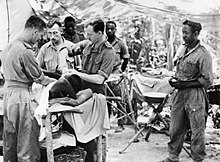81st (West Africa) Division
| 81st (West African) Division | |
|---|---|
 Formation sign of the 81st (West African) Division.[1] | |
| Active | 1943–1945 |
| Allegiance | United Kingdom |
| Branch | British Army |
| Type | Infantry |
| Size | 15,000 personnel |
| Part of | Fourteenth Army (United Kingdom) |
| Engagements | Second World War
|
| Commanders | |
| Notable commanders | Christopher Woolner Frederick Joseph Loftus-Tottenham |
The 81st (West African) Division[2] was formed under British control during the Second World War. It took part in the Burma Campaign.
History[]

The inspiration for the division's formation came from General George Giffard, commander of the British Army's West Africa Command, who subsequently commanded India Command's Eastern Army, facing the Japanese army on the frontier between India and Burma. Giffard had wide experience with African troops, and was eager for them to participate in the war.
The framework around which the division was formed was the Royal West African Frontier Force. One of the brigades (the 3rd West African) and several of the supporting units which formed the division had already seen action with the 11th (African) Division, against the Italians in East Africa.
The division was established as the 1st (West African) Division on 1 March 1943. Three days later it was renamed the 81st (West African) Division, taking the next vacant number in the list of British infantry divisions. The division's badge was a spider, in black on a yellow circular background. This spider was a reference to Ananse, a cunning character in Ashanti mythology, and drawn so that when a soldier raised his weapon to fire, the spider would appear to be going forwards.

The division arrived in India on 14 August 1943. The movement of the 5th (West African) Brigade was delayed, however, after the troopship which was to carry it was lost in the German attack on Convoy Faith off Portugal on the night of 11/12 July 1943. The 3rd (West African) Brigade was detached to the Chindits, and was intended to garrison jungle bases for the raiding columns. The remainder of the division took part in the second Arakan campaign from February to May, 1944, operating in the Kaladan Valley on the flank of Indian XV Corps.
In late March, substantial Japanese reinforcements (with some troops from the Indian National Army) outflanked the division and forced it to retreat over a range of hills out of the Kaladan valley into that of the Kalapanzin.
In August, the division re-entered the Kaladan valley, forcing the Japanese and Indian National Army to abandon Mowdok, a few miles east of the Indian / Burmese frontier. The division then advanced down the valley once again, reaching Myohaung near the mouth of the river on 28 January 1945.
The division was withdrawn to India to rest on 22 April 1945. On 31 August, it was returned to West Africa and disbanded.
Character and organisation[]
The division was originally intended to operate on a pack basis, with porters carrying all equipment and supplies. Lieutenant General William Slim, then commanding XV Corps, commented on first inspecting units of the division in late 1943:
Their discipline and smartness were impressive, and they were more obviously at home in the jungle than any troops I had yet seen... I was at once struck by two things. First, by the horde of unarmed porters who were needed to carry supplies, ammunition, baggage and the heavier weapons, and secondly by the large number of white men in a unit, fifty or sixty to a battalion. Accustomed as I was to Indian battalions in the field with usually only seven or eight Europeans, it struck me as an unnecessarily generous supply.[3]
Order of Battle[]
General Officer Commanding : Major General Frederick Joseph Loftus-Tottenham (as of 1 February 1944):
5th (West African) Infantry Brigade[]
- 5th Battalion, Gold Coast Regiment
- 7th Battalion, Gold Coast Regiment
- 8th Battalion, Gold Coast Regiment
- 5th Light Battery, West African Artillery
- 3rd Field Company, West African Engineers
6th (West African) Infantry Brigade[]
- 1st Battalion, Gambia Regiment
- 1st Battalion, Sierra Leone Regiment
- 4th Battalion, Nigeria Regiment
- 3rd Light Battery, West African Artillery
- 6th Field Company West African Engineers
Divisional Units[]
- 11th (East African) Division Scouts
- 81st (West African) Infantry Division Transport Regiment
- 1st Light Anti-Aircraft/Anti-Tank Regiment, West African Artillery
- 8th Field Park Company West African Engineers
- 81st (West African) Divisional Signals
3rd (West African) Infantry Brigade[]
Detached to Special Force:
- 6th Battalion, Nigeria Regiment
- 7th Battalion, Nigeria Regiment
- 12th Battalion, Nigeria Regiment
See also[]
- Military history of Nigeria during World War II
- The Gambia in World War II
- 82nd (West African) Division
- Seth Anthony, first non-European from Africa to gain the King's Commission
References[]
- ^ Cole p. 92
- ^ Giffard, George (13 March 1951). "Operations in Burma and North-East India from 16th November, 1943 to 22nd June, 1944" (PDF). The London Gazette (Supplement) (39171 ed.). p. 1349. Retrieved 21 December 2019.
- ^ Defeat into Victory, William Slim, Cassell, 1956
Bibliography[]
- Luto, James (2013). Fighting with the Fourteenth Army in Burma. Pen and Sword Military. ISBN 978-1-78303-031-6.
External links[]
- "81 (West Africa) Infantry Division". Orders of Battle.com.
- Burma Star organisation page
- British Military History
- British World War II divisions
- Infantry divisions of the United Kingdom
- Military units and formations established in 1943
- Military units and formations of the British Empire in World War II
- Military units and formations in Burma in World War II
- Military history of the Gambia
- Military units and formations disestablished in 1945